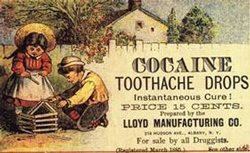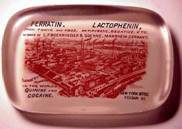Warren Hickinbotham, who sent in the photographs of these products, quipped to the museum's mastermind, Affinity Publishing's Ken Preston, “Maybe this is why our great-grandparents and grandparents were happier people than we are. Certainly, these pharmaceutical products from the late 1800s give new meaning to the words ‘Good old days'.”


The products, several of which were regarded as suitable for children, brazenly feature ingredients that are outlawed in today's medicine. Opium and cocaine (or ‘coca' as it was commonly known) feature in the brand names, with ruddy cheeked children illustrating several of the packs.
Children were introduced to the pleasures of opiates at their mothers' breast. Harassed baby-minders - and overworked parents - found opium-based preparations were a dependable way to keep their kids happy and docile; this was an era before Ritalin.
Sales of Godfrey's Cordial, a soothing syrup of opium tincture effective against colic, were prodigious. However, Godfrey's Cordial had its competitors: Street's Infants' Quietness, Atkinson's Infants' Preservative and Mrs Winslow's Soothing Syrup.
Indeed, one of the products submitted by Hickenbothan, Stickney and Poor's Pure Paregoric, gives strict instructions: ‘Five days old - 5 drops, two week old - 8 drops, five years old - 25 drops, adults - 1 teaspoon full'.

One, a tonic hastening convalescence especially from influenza, claims to be endorsed by the Pope, and there's even an example of what was launched in 1898 as a non-addictive alternative to opium and morphine - the German pharmaceutical giant, Bayer's, best-selling drug-brand of all time, heroin.

According to www.opiates.net, surgeon Sir William Osler regarded opium as ‘God's Own Medicine'. The website tracks the history of opium from the first known written reference to the poppy in a Sumerian text dated around 4 000 BC to the 1991 drug-bust at a university close to the Thomas Jefferson Center for Historic Plants, where opium poppies were thriving.
The website says opium was probably the world's first authentic antidepressant. By the 19th century, vials of laudanum and raw opium were freely available at any English pharmacy or grocery store.
Opium was already heavily used in China as a recreational drug before these ‘English' drugs were introduced. The Imperial Chinese court had banned its use and importation, but large quantities were still being smuggled into the country. In 1839, the Qing Emperor, Tao Kwang, ordered his minister Lin Tse-hsu to take action. Lin petitioned Queen Victoria for help; but he was ignored. In reaction, the Emperor instructed the confiscation of 20,000 barrels of opium and detained some foreign traders. The British retaliated by attacking the port-city of Canton.

This began the First Opium War, launched by the biggest, richest and perhaps most aggressive drug cartel the world has ever known, the British Empire. The Chinese were defeated. They were forced to sign the Treaty of Nanjing in 1842. The British required that the opium trade be allowed to continue; that the Chinese pay a large settlement and open five new ports to foreign trade; and that China cede Hong Kong to Britain.
Peace didn't last. The Second Opium War began and ended in 1856 over western demands that opium markets be expanded. The Chinese were again defeated. In 1858, by the Treaty of Tientsin, opium importation to China was formally legalised. God-fearing British traders claimed that the hard-working Chinese were entitled to ‘a harmless luxury'; the opium trade in less respectable hands would be taken over by "desperadoes, pirates and marauders.” Soon opium poured into China in unprecedented quantities. By the end of the 19th century, it has been estimated that over a quarter of the adult male Chinese population were addicted.


“The story behind the drug and the brands it spawned is fascinating; we are deeply indebted to Warren for letting us add them to the collection,” said Preston.
“Preserving the history of South Africa's brands is the museum's primary objective because the influence those brands exert on consumer behaviour means they have also become part of the social history of the times, reflecting the fashion, art, literature, technology, health, sport and social norms of the day.
“The early days of branding in South Africa date back 200 years to a number of iconic brands that remain very much a part of the branding scene today. Brands like Nederburg, Mrs Ball's and Red Heart Rum. Many others from the 1800s onwards have also stood the test of time and have rich and instructive histories to share.
The Brand Museum's modest start-up collection includes:
Roy Clucas Design Process created the museum logo, in static and animated form.

Preston is still interested in hearing from interested parties who want to donate or loan appropriate items, and in time, assist by providing a venue to showcase this fascinating archive. It is proposed that the museum venue will be large enough to host exhibitions, workshops, seminars, product and book launches, meetings, lunches and so on to help cover operating costs.
If you are able to help by dating, providing information on the products, posters or ads on the site, or would like to contribute or loan items to the museum go to www.thebrandmuseum.co.za or contact .